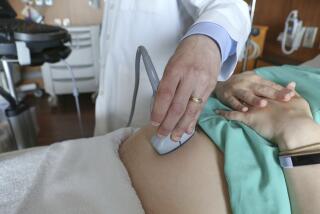Pediatric Trauma System Dependent on Helicopters
- Share via
The city Fire Department helicopter that crashed Monday, killing 11-year-old Norma Vides-Anaya and three rescue workers, was part of a countywide emergency system that requires critically injured children in the San Fernando, east San Gabriel and Antelope valleys to be taken by helicopter to distant trauma centers.
With a limited number of such facilities capable of caring for children, the sprawling system relies on speed and the skill of helicopter pilots to deliver young patients to one of nine pediatric trauma centers.
For the record:
12:00 a.m. March 26, 1998 For the Record
Los Angeles Times Thursday March 26, 1998 Home Edition Metro Part B Page 3 Metro Desk 1 inches; 28 words Type of Material: Correction
Trauma centers--An article in Wednesday’s Times misstated the number of people cared for in 1997 at the 13 trauma centers in Los Angeles County. An estimated 14,000 people were treated at the centers.
Pediatric trauma centers use special medical equipment, including custom-designed instruments to measure blood pressure and smaller-gauge needles.
The system has been sharply reduced in size. Escalating emergency care costs combined with fewer numbers of insured residents has prompted the closure of 11 trauma centers in Los Angeles County since 1985.
“If we had a pediatric trauma center in the San Fernando Valley, that would mitigate the need for most of those air ambulance runs,” said Dr. Marc Eckstein, medical director for the city fire department.
Los Angeles Councilman Richard Alarcon said it is “distressing” the Valley has no children’s trauma center, and called Tuesday for a city study.
Opinion in the medical community is divided over whether the current trauma care system is adequate.
Alan Heilpren, an emergency room physician and president of the Los Angeles County Medical Assn., said the county system works well. He said the concentration of trauma centers at a handful of hospitals allows for physicians to become expert in the treatment of devastating injuries.
“There is absolutely not enough pediatric trauma to support pediatric critical care centers at every hospital,” he said. “If I’m a pediatric surgeon on staff at a hospital that rarely sees pediatric trauma, I’m not going to be very good.”
But his immediate predecessor at the association, emergency room physician Brian Johnston, said surviving an accident may depend on proximity to the nearest trauma center.
“The care that the little girl who was hurt was receiving was necessary and appropriate,” said Johnston of the rescue crew’s decision to fly Vides-Anaya from Sun Valley to Childrens Hospital in Hollywood. “But she had to go there because there was no place locally that could treat her. There was no place locally because we aren’t willing to pay for it.”
The distinction between pediatric and adult care is important in a 4,000-square-mile county that has 13 trauma centers for adults, but only nine certified for children.
Last year an estimated 1,400 people were treated at county trauma centers. Of that number, about 1,800 children were treated at local pediatric trauma centers, according to the county Department of Health Services.
Northridge Hospital Medical Center--which along with Providence Holy Cross in Mission Hills is one of two trauma centers in the San Fernando Valley--is considering applying for status as a pediatric trauma center.
To be designated a pediatric critical care center, a hospital must be staffed with pediatric surgeons and physicians 24 hours a day, and have pediatric specialists no more than 20 minutes away.
Ladonna DellaGala, manager of pediatric care at Northridge, said it is expensive but possibly worthwhile, considering there are nearly 1.5 million Valley residents.
“Even after a child is treated, parents have to keep running over the hill to visit, even if they live just down the block from a hospital in their neighborhood,” said DellaGala. Caring for children under the age of 16, say medical experts, is not simply like treating smaller adults.
“A child’s head is much larger in proportion to the body than an adult’s,” said Alan Nager, acting head of emergency medicine at Childrens Hospital, where Vides-Anaya was being flown for treatment. “There is a difference in body fluids. Children can have injuries that go unrecognized by those that do not regularly treat them.”
(BEGIN TEXT OF INFOBOX / INFOGRAPHIC)
Trauma Network
Last year, an estimated 14,000 people, including 1,800 children, were served by Los Angeles County’s 13 trauma centers, nine of which are designed to treat children 14 and younger. There are no pediatric trauma centers in the San Fernando Valley.
1) Cedars-Sinai Medical Center
2) Children’s Hospital Los Angeles
3) Henry Mayo Newhall Memorial Hospital
4) Huntington Memorial Hospital
5) Harbor-UCLA Medical Center
6) King/Drew Medical Center
7) USC Medical Center
8) Long Beach Memorial Medical Center
9) Northridge Hospital Medical Center
10) Providence Holy Cross Medical Center
11) St Francis Medical Center
12) St. Mary Medical Center
13) UCLA Medical Center
Source: L.A. County Department of Health Services
More to Read
Sign up for Essential California
The most important California stories and recommendations in your inbox every morning.
You may occasionally receive promotional content from the Los Angeles Times.











